#Learning Embedded Linux with ARM
Explore tagged Tumblr posts
Text
Embedded Linux ARM
Embedded Linux: The Heart of Modern Devices Embedded Linux is a lightweight version of the Linux operating system, optimized for embedded systems- specially designed computing devices whose purpose is to be integrated into any hardware. Embedded Linux has been widely used in IoT devices, automotive systems, industrial automation, and more in the application mainly because of its elasticity and efficiency.

Embedded Linux is designed to run effectively within constrained resource environments unlike traditional operating systems. Another key advantage of Embedded Linux is that developers can customize the kernel and software stack according to specific hardware requirements. Its scalability and robust community support give access to a large number of libraries and tools, reducing development time and cost. Moreover, because of its real-time processing capabilities and multiple communication protocol support, it has received immense importance in robotics, medical appliances, and smart appliances. Through its Embedded Linux course, Emblogic offers comprehensive training to meet the ever-increasing demand for skilled professionals in this field. This hands-on program equips participants with the knowledge and skills required to work with Embedded Linux systems, covering essential topics like kernel programming, device drivers, and system optimization. Emblogic has designed its curriculum to be industry-aligned, ensuring students are adequately equipped to face real-world challenges in this exciting domain. Therefore, for fresh professionals, Embedded Linux and its training at Emblogic lead to richer career opportunities in developing embedded systems.
Embedded Linux with ARM, Embedded Linux with ARM training, Embedded Linux with ARM course, Embedded Linux with ARM online, Embedded Linux with ARM training online, Embedded Linux with ARM course online, Embedded Linux with ARM online training, Embedded Linux with ARM online course, project-based Training in Embedded Linux with ARM, project and training in Embedded Linux with ARM, Development Designing Embedded Linux with ARM, Learning Embedded Linux with ARM.
#Embedded Linux with ARM#Embedded Linux with ARM training#Embedded Linux with ARM course#Embedded Linux with ARM online#Embedded Linux with ARM training online#Embedded Linux with ARM course online#Embedded Linux with ARM online training#Embedded Linux with ARM online course#project-based Training in Embedded Linux with ARM#project and training in Embedded Linux with ARM#Development Designing Embedded Linux with ARM#Learning Embedded Linux with ARM
0 notes
Text
Transform Your Career with TechnoScripts’
Embedded Systems Training in Pune
Embedded systems are the backbone of upcoming modern technology, quietly running everything from your smartphone to the navigation system in your car. As industries like IoT, automotive, & healthcare expand, companies are seeking for engineers who can design, program, & troubleshoot these critical systems. But landing a role in this field or advancing in it needs a lot more knowledge. You need to stand out in interviews, build a strong online presence, and show employers you’re ready for real-world challenges. That’s where TechnoScripts, a leading embedded systems training institute in Pune, steps in. Their four-month Advance Career Track in Embedded Systems is built to equip both fresh graduates and seasoned professionals with the skills and tools to succeed. Here’s a look at the nine key features that make this program a standout: mock interviews, LinkedIn profile optimization, ATS-friendly resume crafting, 100% placement assistance, internship opportunities, flexible learning options, hands-on projects, professional profile building, and mentorship from industry veterans.
Why Choose Embedded Systems as a career?
Embedded systems make various technologies possible, & as innovation surges, so does the need for skilled engineers and Technoscripts is fulfilling that demand. In 2025, employers are finding talent who can tackle tasks like programming microcontrollers & integrating IoT solutions. But to get hired, you need to shine in 1000s of candidates. TechnoScripts’ program doesn’t just teach you the technical stuff it prepares you to navigate the job market with confidence.
Nine Features That Set TechnoScripts Apart
Mock Interviews: Sharpen Your Skills Job interviews for embedded systems roles can be intense, with questions ranging from embedded C coding to real-time operating systems. TechnoScripts offers mock interviews led by industry pros who’ve been on both sides of the table. These sessions feel like the real thing, covering technical challenges and HR-style questions. You’ll get feedback on how to explain your projects better or come across more confidently—think of it as a dress rehearsal for your dream job.
LinkedIn Optimization: Get Noticed Online Your LinkedIn profile is the 1st thing recruiters see. TechnoScripts helps you make it very sharp & professional, with a headline that gets attention (like “Embedded Systems Engineer Focused on IoT Innovation”) & a summary that tells your unique story & Skillset. You’ll learn to highlight skills like sensor integration or ARM programming and share project updates to build credibility. They even offer tips on connecting with industry folks, so your profile works for you 24/7.
ATS-Friendly Resumes: Pass the Digital Gatekeepers Ever sent out a resume and heard nothing back? Chances are, an Applicant Tracking System (ATS) filtered it out. TechnoScripts shows you how to create a resume that beats these systems by weaving in keywords like “embedded Linux” or “microcontroller design” naturally. They’ll guide you on structuring your experience to showcase projects and certifications clearly, ensuring your resume lands in front of a hiring manager.
100% Placement Assistance: Your Path to a Job TechnoScripts doesn’t just train you—they help you cross the finish line. Their placement team works tirelessly to connect you with top companies in the embedded systems space. From fine-tuning your resume to arranging campus recruitment drives, they’re your partner in the job hunt, giving you access to opportunities that match your skills and goals in Embedded Systems Course in Pune with Placement.
Internship Opportunities & the Real-World Experience Nothing impresses employers like hands-on experience. TechnoScripts provides internship letters that open doors to roles where you might code IoT software or debug hardware systems. These internships let you apply what you’ve learned and give you stories to share in interviews—like the time you fixed a tricky sensor issue. That kind of experience makes your resume pop.
Flexible Learning Options: Fit Training Into Your Life Whether you’re a student or a working professional, TechnoScripts makes learning accessible. You can attend in-person classes at their Pune facility, where you’ll work with real hardware and collaborate with peers, or opt for online sessions that are just as engaging. With early morning, evening, and weekend batches, you can balance training with your busy schedule.
Hands-On Projects: Build What Matters This program is all about doing. You’ll work on at least two live projects, like creating an IoT device or programming a microcontroller to manage sensors. These projects mirror real job tasks, teaching you how to solve problems under pressure. Plus, they give you something concrete to show employers, proving you can handle the challenges they care about.
Professional Profile Building: Stand Out in the Crowd In a competitive market, a polished professional profile can set you apart. TechnoScripts helps you craft one that highlights your skills, projects, and the certificate you’ll earn. They’ll coach you on presenting your work—like a project where you integrated a sensor array—in a way that catches employers’ eyes, making you a top candidate.
Mentorship from Industry Experts: Learn from the Best The instructors at TechnoScripts aren’t just teachers—they’ve built real products and solved real problems in the embedded systems world. They’ll guide you through complex topics like embedded C or IoT protocols, sharing insights you won’t find in textbooks. Their mentorship prepares you for the realities of the job, not just the theory.
Why TechnoScripts Stands Out
The Embedded Course in Pune covers 12 modules, from digital electronics to advanced IoT and embedded Linux, all taught through hands-on practice. With flexible training, real-world projects, and a strong placement record, TechnoScripts ensures you’re ready for the industry. Their mentors, who’ve worked on cutting-edge systems, bring practical knowledge that bridges the gap between learning and doing.
How to Get Started
Ready to jump in? Visit TechnoScripts’ website or reach out to their admissions team for details on batches, fees, and enrollment. They offer regular and fast-track options, plus schedules tailored for working professionals, so you can find what works for you.
Final Thoughts
The embedded systems industry is brimming with opportunity, but breaking in requires the right preparation. TechnoScripts’ Embedded Systems Course in Pune delivers the technical skills and career tools you need—from mock interviews to hands-on projects and expert mentorship. Enroll now to start building a career that makes an impact in this fast-growing field.
0 notes
Text
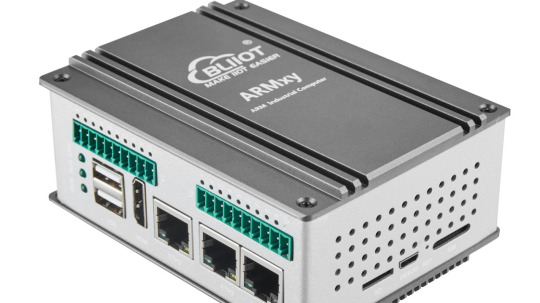
Launched New ARM Embedded Industrial Computer with RK3562J for ARMxy Series
The BL370 series is powered by the industrial-grade Rockchip RK3562/RK3562J processor, featuring a multi-core heterogeneous architecture with a quad-core ARM Cortex-A53 and a single-core ARM Cortex-M0, clocked at up to 1.8GHz/2.0GHz. It offers a robust solution with 4GB LPDDR4X RAM and 32GB eMMC storage, along with a rich set of I/O interfaces. The built-in 1 TOPS NPU supports deep learning capabilities, making it ideal for AI-driven applications.
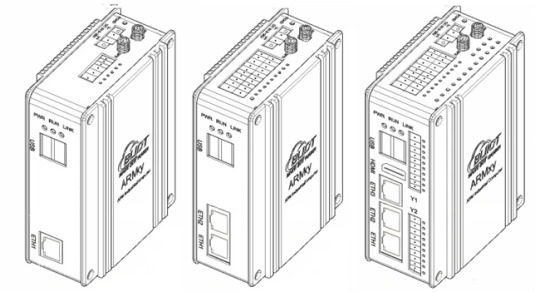
Key Features:
High Reliability and Cost-Effectiveness: The BL370 series is widely used in industrial control, edge computing, AIoT, artificial intelligence, communication management, AGV robots, machine vision, robotics, industrial IoT gateways, energy storage systems, automation control, and rail transportation.
Versatile Connectivity:
Data Acquisition and Control: Supports communication, PWM output, pulse counting, and more.
Video Processing: Capable of 1080P@60fps H.264 encoding and 4K@30fps H.265 decoding.
Wireless Communication: Built-in Mini PCIe interface supports Bluetooth, WiFi, 4G, and 5G modules.
Software and Development Support:
Operating Systems: Linux-5.10.198, Linux-RT-5.10.198, Ubuntu 20.04, Debian 11 (planned), Android 13 (planned).
Development Tools: Docker containers, Node-RED, and Qt-5.15.2 for GUI development.
Industrial Software:
Robust Design for Harsh Environments:
The BL370 series has undergone professional electrical performance design and high/low-temperature testing, ensuring stable operation in extreme conditions with temperatures ranging from -40°C to 85°C and resistance to electromagnetic interference. Its DIN35 rail mounting makes it suitable for various industrial applications.
Typical Application Areas:
Industrial Control
Energy Storage Systems (EMS/BMS)
AIoT and Artificial Intelligence
Smart Manufacturing
Communication Management
AGV Robots
Machine Vision
Edge Computing
Motion Control
Robotics
Rail Transportation
Smart Devices
The BL370 series combines high performance, reliability, and versatility, making it an ideal solution for demanding industrial and IoT applications.
0 notes
Text
New Release | Forlinx Embedded × Nuvoton Collaboration We’re excited to announce the launch of the FET-MA35-S2 multi-core heterogeneous embedded board, developed by Forlinx Embedded in partnership with Nuvoton Technology—engineered specifically for EV charging station TCUs!

🔹 Multi-Core Heterogeneous Architecture
2× ARM Cortex-A35 @ 800 MHz + 1× Cortex-M4 @ 180 MHz
Linux + RTOS dual-system coordination for high performance and real-time control
🔹 Rich Interfaces & Modular Customization
17× UART, 4× CAN-FD, 2× Gigabit Ethernet, 8× ADC + PWM
Optional Wi-Fi/4G, touch-screen, camera modules—flexible for diverse deployment scenarios
🔹 Hardware-Level Security (Nuvoton TSI & TrustZone)
Integrated Nuvoton TSI Trusted Secure Island, AES/SHA/ECC/RSA accelerators, TRNG
Secure boot & firmware integrity checks to safeguard payments and data privacy
🔹 Industrial-Grade Reliability
Wide temperature range: –40 °C to 85 °C, EMC interference certified
MTTF ≥ 100,000 hours for continuous, dependable operation
👉 Learn more & request an evaluation board
#ForlinxEmbedded#Nuvoton#EVCharging#TCU#EmbeddedSystems#MultiCore#IndustrialGrade#Cybersecurity#ElectricVehicles
0 notes
Text
Introduction to Microsoft Azure Basics: A Beginner's Guide
Cloud computing has revolutionized the way businesses are run, facilitating flexibility, scalability, and innovation like never before. One of the leading cloud providers, Microsoft Azure, is a robust platform with an unparalleled set of services that cover from virtual machines and AI to database management and cybersecurity. Be it a developer, IT expert, or an interested individual curious about the cloud, getting a hold of Azure fundamentals can be your gateway into an exciting and future-proof arena. In this beginner's tutorial, we'll learn what Azure is, its fundamental concepts, and the most important services you should know to begin your cloud journey. What is Microsoft Azure? Microsoft Azure is a cloud computing service and platform that has been developed by Microsoft. It delivers many cloud-based services such as computing, analytics, storage, networking, and other services. These services are made available by selecting and using those for the purpose of building new applications as well as running already existing applications. Launched in 2010, Azure has developed at a lightning pace and now caters to hybrid cloud environments, artificial intelligence, and DevOps, becoming the go-to choice for both enterprises and startups.
Why Learn Azure? • Market Demand: Azure skills are in demand because enterprises use it heavily. • Career Growth: Azure knowledge and certifications can be a stepping stone to becoming a cloud engineer, solutions architect, or DevOps engineer. • Scalability & Flexibility: Solutions from Azure can be offered to businesses of all types, ranging from startups to Fortune 500. • Integration with Microsoft Tools: Smooth integration with offerings such as Office 365, Active Directory, and Windows Server. Fundamental Concepts of Microsoft Azure Prior to services, it would be recommended to familiarize oneself with certain critical concepts which constitute the crux of Azure.
1. Azure Regions and Availability Zones Azure can be had in every geographic area globally, regions being divided within them. Within regions, redundancy and resiliency can be had through availability zones—separate physical data centers within a region. 2. Resource Groups A resource group is a container holding Azure resources that belong together, such as virtual machines, databases, and storage accounts. It helps group and manage assets of the same lifecycle.
3. Azure Resource Manager (ARM) ARM is Azure's deployment and management service. It enables you to manage resources through templates, REST APIs, or command-line tools in a uniform way. 4. Pay-As-You-Go Model Azure has a pay-as-you-go pricing model, meaning you pay only for what you use. It also has reserved instances and spot pricing to optimize costs.
Top Azure Services That Every Beginner Should Know Azure has over 200 services. As a starter, note the most significant ones by categories like compute, storage, networking, and databases. 1. Azure Virtual Machines (VMs) Azure VMs are flexible compute resources that allow you to run Windows- or Linux-based workloads. It's essentially a computer in the cloud. Use Cases: • Hosting applications • Executing development environments • Executing legacy applications
2. Azure App Services It's a fully managed service for constructing, running, and scaling web applications and APIs. Why Use It? • Automatically scales up or down according to demand as well as remains always available • Multilanguage support (.NET, Java, Node.js, Python) • Bundled DevOps and CI/CD 3. Azure Blob Storage Blob (Binary Large Object) storage is appropriate to store unstructured data such as images, videos, and backups. Key Features: • Greatly scalable and secure • Allows data lifecycle management • Accessible using REST API
4. Azure SQL Database This is a managed relational database service on Microsoft SQL Server. Benefits: • Automatic updates and backups • Embedded high availability • Has hyperscale and serverless levels 5. Azure Functions It is a serverless computing service that runs your code in response to events. Example Use Cases: • Workflow automation • Parsing file uploads • Handling HTTP requests 6. Azure Virtual Network (VNet) A VNet is like a normal network in your on-premises environment, but it exists in Azure. Applications: • Secure communication among resources • VPN and ExpressRoute connectivity
• Subnet segmentation for better control
Getting Started with Azure 1. Create an Azure Account Start with a free Azure account with $200 credit for the initial 30 days and 12 months of free-tier services. 2. Discover the Azure Portal The Azure Portal is a web-based interface in which you can create, configure, and manage Azure resources using a graphical interface. 3. Use Azure CLI or PowerShell For command-line fans, Azure CLI and Azure PowerShell enable you to work with resources programmatically. 4. Learn with Microsoft Learn Microsoft Learn also offers interactive, role-based learning paths tailored to new users. Major Azure Management Tools Acquiring the following tools will improve your resource management ability: Azure Monitor A telemetry data gathering, analysis, and action capability for your Azure infrastructure. Azure Advisor Offers customized best practice advice to enhance performance, availability, and cost-effectiveness. Azure Cost Management + Billing Assists in tracking costs and projects costs in advance to remain within budget.
Security and Identity in Azure Azure focuses a great deal of security and compliance. 1. Azure Active Directory (Azure AD) A cloud identity and access management. You apply it to manage identities and access levels of users for Azure services. 2. Role-Based Access Control (RBAC) Allows you to define permissions for users, groups, and applications to certain resources. 3. Azure Key Vault Applied to securely store keys, secrets, and certificates.
Best Practices for Azure Beginners • Start Small: Start with straightforward services like Virtual Machines, Blob Storage, and Azure SQL Database. • Tagging: Employ metadata tags on resources for enhanced organization and cost monitoring. • Monitor Early: Use Azure Monitor and Alerts to track performance and anomalies. • Secure Early: Implement firewalls, RBAC, and encryption from the early stages. • Automate: Explore automation via Azure Logic Apps, ARM templates, and Azure DevOps.
Common Errors to Prevent • Handling cost management and overprovisioning resources lightly. • Not backing up important data. • Not implementing adequate monitoring or alerting. • Granting excessive permissions in Azure AD. • Utilizing default settings without considering security implications. Conclusion
Microsoft Azure is a strong, generic platform for supporting a large variety of usage scenarios—everything from a small web hosting infrastructure to a highly sophisticated enterprise solution. The key to successful cloud computing, however, is an understanding of the basics—ground-level concepts, primitive services, and management tools—is well-served by knowledge gained here. And that's just the start. At some point on your journey, you'll come across more complex tools and capabilities, but from a strong base, it is the secret to being able to work your way through Azure in confidence. Go ahead and claim your free account, begin trying things out, and join the cloud revolution now.
Website: https://www.icertglobal.com/course/developing-microsoft-azure-solutions-70-532-certification-training/Classroom/80/3395

0 notes
Text
Intel Quartus Prime Pro Edition 25.1 Optimized for Agilex 3

Altera Launches Quartus Prime Pro Edition 25.1 for Agilex 3 FPGAs
Now available is Quartus Prime Pro 25.1, which supports Agilex 3, the latest Agilex release. Developers may design high-performing, power-efficient edge and embedded programs with this update.
Comprehensive Agilex 3 FPGA support
Agilex 3 FPGA family offers cost optimisation, high performance, and power efficiency for edge and embedded applications. This version lets you develop, test, and implement solutions faster with Agilex 3 higher-speed transceivers, on-chip dual Cortex-A55 ARM CPUs, and increased memory support, including LPDDR4.
For small board space applications, Agilex 3 uses Intel's variable pitch BGA packaging to design more efficiently and compactly. With this technology, developers can maintain performance and power efficiency while adding functionality to smaller spaces.
Security is essential for FPGA applications to protect sensitive data and IP. Agilex 3's physical security, authentication, and encryption capabilities strengthen designs' manipulation and assault resistance.
Nios V Soft Processor Enhancements
Nios V is vital for embedded applications and improves efficiency and performance. These improvements allow developers to make smaller, more efficient embedded devices.
Improved Nios V/g Core Performance Improved work completion and overall performance.
Nios V/c Core Area reduction saves 8% space, leading in smaller designs.
The Ashling RISCFree IDE's Visual Studio Code plugin simplifies Nios V software development.
TinyML Example Design with Nios V Application Note lets developers add machine learning (ML) to FPGA designs utilising microcontrollers.
Features of Embed Software
FPGA-based embedded applications need strong OS and virtualisation support. By adding Linux, RTOS, and hypervisor support, Quartus Prime Pro 25.1 lets developers build scalable, real-time, and virtualised embedded systems.
Linux Hardware Reference Designs Regular and standard editions for Linux development.
To support Xen, developers can virtualise FPGA programs.
RTOS supports Zephyr and Bare Metal, and FreeRTOS will arrive in Q2 (May).
Installer Improvements: Faster, flexible configuration
FPGA software should install and adapt easily. Quartus Prime Pro 25.1 improves installation with parallel processing, configurable component selection, and file management.
Installation in Parallel speeds up setup by installing many components simultaneously.
By letting users choose just the bits they need, Dynamic Components decrease installation time and disc space.
Troubleshoot hardware quickly with streaming debugging
Effective debugging reduces development cycles. The Streaming Debug IP for Signal Tap helps engineers debug FPGA designs by capturing real-time, high-bandwidth data.
Hardware debugging streaming allows real-time data flow for analysis.
Configurable streaming via STP Signal Tap Logic Analyser configures streaming and selects a debug host.
Simulation Enhancements
Quartus Prime Pro 25.1 improves integration, long-term support, and simulation with new native Altera AXI4 Bus Functional Models (BFMs).
Optimised for Quartus simulation workflows, native Altera AXI4 BFMs increase performance and compatibility.
Smooth Change With better toolchain integration, customers may switch to Altera AXI4 BFMs without substantial modifications.
Quartus Prime Pro 25.1 improves simulation performance, notably for transceiver protocol IP, enabling faster debugging and verification.
Better Transceiver Protocol IP simulation enhances PCIe, Ethernet, Serial Lite, JESD, and other transceiver protocols.
25.1 Beta Models The new simulation models for this edition focus on Ethernet and PCIe and are under beta testing.
Improved Efficiency Usually, 50% or more improvements speed up verification and reduce simulation time.
These simulation additions improve Quartus Prime Pro 25.1's transceiver-based FPGA design capabilities by speeding up simulations and reducing verification time.
Extra Quartus Prime Pro 25.1 Updates
QPDS Standard & Pro Containerised Images Docker Hub offers Quartus Prime Standard and Pro Editions containerised, simplifying deployment and improving cloud and CI/CD compatibility.
Separating timed closure data from Design Assistant results simplifies failure classification in Summary of Design Closure.
SDC Relative File Paths improve portability and script management for Synopsys Design Constraints (SDC) reports.
MTBF improvements It lets users adjust instance toggling rates to improve MTBF when default toggle rates are not suitable.
Static timing analysis improvements in Quartus Prime Pro 25.1 speed up timing problem identification and resolution.
Synthesis supports basic Quad-Port RAM. Automatic quad-port RAM inference expands memory design flexibility.
Complete Support for Byte Enable Inference in Synthesis: This adds 8-bit byte enables and supports 5, 8, 9, and 10-bit combinations, matching hardware capabilities.
Correcter Management Users can now write individual bytes within a word using the byte enable control signal to increase memory access and performance.
Better RAM inference lets designers use FPGA memory more readily.
FPGA AI Suite: Improved Usability and AI
As AI advances, FPGA-based inference systems must be more flexible and effective. This release includes better performance estimation, model support, and Agilex FPGA integration.
Support Agilex 3 Beta FPGA AI Suite beta supports Agilex 3 FPGAs. Build in Quartus with Agilex 3 and generate Inference IP targeting Agilex 5 in the architectural configuration file.
The RPM and DEB packages are now called “altera-fpga-ai-suite-” and the AI Suite is installed in “/opt/altera” instead of “/opt/intel”.
YoloV7 Model Support enables high-accuracy object recognition in robotics, surveillance, and industrial quality control.
Agilex 5 FPGA E-Series Example Design Support New Agilex 5 FPGA E-Series 065B Modular Development Kit sample designs are available.
This SoC example uses an ARM host CPU for AI inference. AI Inference IP and a novel layout transform enable folding and run-time configurability to improve AI model performance and usability.
Example of Hostless JTAG-Attach Design A system console linked to the Inference IP via JTAG allows users to setup and control IP functionality step-by-step.
Performance Estimator Uses Memory Bandwidth Users may now define external memory bandwidth when designing for memory-limited devices like Agilex 5 and Agilex 3, improving accuracy.
OpenVINO 2024.6 Integration FPGA AI Suite 25.1 uses the latest OpenVINO 2024.6 for stability and maintainability.
For two years, Quartus Prime Pro versions will only include the Long-Term Support AI Suite, which uses new optimisations and performance improvements.
FPGA AI Suite 25.1 simplifies FPGA AI inference with faster performance, more example designs, and greater model support.
Quartus Prime Pro 25.1 IP Features
After adding Agilex 3 IP cores and upgrading Agilex 5, Quartus Prime Pro 25.1 delivers real-time data processing, flexible memory access, and rapid connectivity for many applications.
Agilex 3 IPs
Agilex 3 has a wide range of memory, processor, and connectivity IPs for low-cost applications:
1.25 Gbps LVDS and MIPI D-PHY high-voltage and fast adaptable I/O Assistance interfaces.
PCIe 3.0, 10GE Hard IP, and 12.5Gbps transceivers ensure high-bandwidth applications.
LPDDR4 provides cost-effective embedded memory up to 2133 Mbps.
HPS EMIF ensures tight ARM Cortex integration.
HD Image and Video Processing Our VVP package accelerates video and vision processing applications.
JESD204B for Synchronising Data Converters synchronises 12.5Gbps multi-channels accurately.
The Transceiver Toolkit for Advanced Debugging improved transceiver link testing and debugging.
Agilex 5 IP updates
Performance and flexibility enhancements to Agilex 5 series IP include:
PMA-Direct real-time adaptive reconfiguration of multiple configurations
PCIe 3.0/4.0 Multi-Channel DMA supports x2/x4 Root Port (RP) and Endpoint (EP) modes.
Agilex 5 D Series enabled 12.5 Gbps per serial channel in Interlaken for scalable data transport.
Transceiver Toolkit 17.16 Gbps JESD204B Advanced Debugging ensures rapid, accurate data flow.
Dual-Simplex Mode Protocol JESD204C expands high-speed ADC/DAC interface for more advanced signal processing.
O-RAN IP: Supports 15–240 KHz subcarrier frequencies and real-time spacing changes via control messages. Scalable and conserved digital power.
The Agilex 3 and Agilex 5 FPGAs are ideal for embedded, networking, and AI-driven applications due to their performance, efficiency, and adaptability.
Conclusion
Quartus Prime Pro 25.1 improves Agilex 3 support, debugging tools, AI acceleration, IP cores, and usability. Optimisation for embedded apps, high-speed interfaces, or AI workloads is faster, more efficient, and more flexible with this version.
#technology#technews#govindhtech#news#technologynews#Quartus Prime Pro#Agilex 3 FPGAs#Agilex 3#Agilex 5#Agilex 5 FPGAs#Quartus Prime Pro Edition 25.1#Quartus Prime Pro Edition
0 notes
Text

Top 10 Skills You’ll Learn in an Embedded System Development Course in India
Today, with advanced technology in every field, the world has taken a big step toward creating new industries and innovations. It is one of the most challenging and exciting fields, and it's worth investing in by enrolling in an embedded system development course in India. The knowledge and skills gained are useful for outstanding performance in various domains such as IoT, robotics, and automotive technology. Here, we look at the top 10 skills you would learn in an embedded system development course, including a fascinating project initiative, TechnosCOE.
1. Familiarity with Microcontrollers and Microprocessors
Microcontrollers and microprocessors are the foundation base for embedded systems. Courses include architecture, functioning, and programming, with hands-on experience in popular controllers such as Arduino, PIC, and ARM, which form the backbone of most embedded applications.
2. Programming Languages
One of the main emphases of an embedded system development course in India is acquiring skills in programming languages such as C and C++. These skills are essential to writing firmware and developing applications for embedded systems. It also makes some courses introduce Python for scripting and debugging purposes to improve a student's versatility.
3. Real-Time Operating Systems (RTOS)
The creation of efficient and reliable systems is based on the understanding of how RTOS works. These courses cover the principles of multitasking, scheduling, and inter-process communication. By mastering RTOS concepts, students can develop systems for industries such as telecommunications and healthcare.
4. Circuit Design and PCB Development
These contain custom circuitry designs and a printed circuit board (PCB). The knowledge gained from developing circuitry robust and efficient within Eagle and Altium Designer gives immense value toward the prototyping and product development phase.
5. Sensor integration and data acquisition
Modern embedded systems interact with the physical world through sensors. Courses teach students how to integrate sensors, process their data, and use it in meaningful ways. Applications include temperature monitoring, motion detection, and environmental sensing, among others.
6. IoT (Internet of Things) Development
IoT has changed the face of industries, and at the center of this change is the concept of embedded systems. Students are taught to design devices that are internet-enabled, which can talk to other devices, and perform analytics in real-time data. The same skill can be applied to smart home automation and industrial applications.
7. Embedded Linux
Training on Embedded Linux is generally a part of an embedded system development course in India. It is a highly versatile and widely used open-source software in the world of embedded systems. A student learns how to develop applications, configure the kernel, and build custom distributions for different types of devices.
8. Debugging and Testing Techniques
Debugging is a key tool in embedded system development. Students become experts in using tools like JTAG debuggers and oscilloscopes to identify and debug those issues. Techniques on testing address all the requirements for the performance and safety of the system.
9. Communication Protocols
Understanding communication protocols is very important to the embedded engineers. The curriculum covers some popular protocols such as I2C, SPI, UART, CAN, and Ethernet, which are usually used in applications such as car systems and automation in industrial places.
10. Project Management and Documentation
Beyond technical skills, students also learn project management techniques and documentation practices. These soft skills ensure that they can efficiently collaborate with teams, manage timelines, and maintain accurate records of their work.
Role of TechnosCOE in Embedded Learning
Most embedded system courses include real-world projects that allow students to apply their skills practically. TechnosCOE is one such project, an initiative designed to bridge the gap between theoretical knowledge and practical application. TechnosCOE offers students opportunities to work on cutting-edge projects involving IoT, robotics, and smart devices.
This initiative focuses on teamwork, innovation, and problem-solving, ensuring learners are industry-ready. Through the TechnosCOE, students are exposed to real-world challenges and learn how to apply embedded system principles to develop effective solutions.
Why Choose an Embedded System Development Course in India?
India is turning out to be a fast-growing hub for embedded technology. Industries like automotive, healthcare, and consumer electronics will have a vast number of opportunities. Embedded system development courses offered in India will ensure expert faculty members, state-of-the-art labs, and industrial collaborations. They also offer internship and placement support, which proves to be perfect for career growth.
Conclusion
The course on embedded system development course in India not only gives the students technical expertise but also prepares them for dynamic and rewarding careers. Mastering microcontrollers to developing IoT solutions, these skills are invaluable in today's technology-driven world. Initiatives like TechnosCOE further enhance the learning experience, making these courses a worthwhile investment for aspiring engineers.
0 notes
Text
Mapping Hardware to Software: Understanding Devicetrees
We learned how to enable and disable particular Zephyr subsystems using the "Kconfig" infrastructure in the previous blog post, "Getting Started With Zephyr: Kconfig." In particular, we looked at the Kconfig infrastructure's three primary components. To enable the LED subsystem, we first looked at an example of a Kconfig file and how the Kconfig infrastructure is constructed. Second, we observed how the Nordic VS Code Extension's GUI-based Kconfig interface can be used to enable or disable particular Zephyr subsystems. Lastly, we observed a way to modify Zephyr that can be integrated into systems that rely on CI/CD.
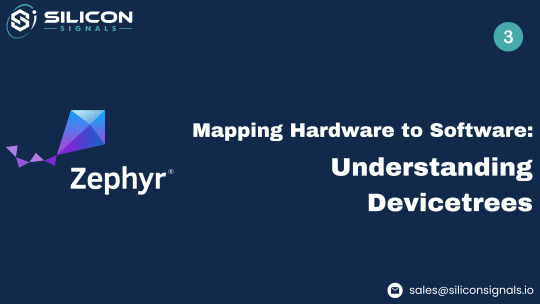
Adding support for communication buses and peripherals is a standard step in embedded software development, in addition to modifying an RTOS to enable or disable particular subsystems. Other MCU vendors integrate customization features into their IDE, such as enabling communication buses and configuring their parameters, as was discussed in the previous blog post. However, Zephyr also uses the "Devicetree," another construct from the Linux kernel (keep in mind that Kconfig also comes from the Linux kernel). Devicetree, or DT for short, is a data structure that describes hardware using its own language.
As ARM-based System-on-Chips (SoCs) and System-on-Modules (SoMs) running embedded Linux gained popularity, so did Devicetrees in embedded software. Bus designs that enabled automatically identifying the hardware connected to the CPU were used when Linux was first developed on Intel-based CPUs. The hardware did not need to be described in advance. However, new communication protocols and buses without any detection mechanism were introduced when ARM exploded onto the scene. As a result, the Linux kernel required a tool to recognize these buses and the devices they were connected to. Though Zephyr borrowed the devicetree concept from the Linux kernel, it is important to remember that Zephyr's use of the devicetree differs sufficiently from the Linux kernel.
BASIC SYNTAX
One of the most crucial things to keep in mind about the devicetree—which typically causes anxiety for embedded software engineers who are not familiar with Linux—is that it is neither magical nor enigmatic. All it is is a file with a vague structure. Each node in the file contains a specific set of definitions. Other nodes can include and reference a node. For instance, the LEDs found on a Nordic nRF52840 development kit are described in the following excerpt.
(https://www.nordicsemi.com/Products/Development-hardware/nrf52840-dk): leds { compatible = "gpio-leds"; led0: led_0 { gpios = <&gpio0 13 GPIO_ACTIVE_LOW>; label = "Green LED 0"; }; led1: led_1 { gpios = <&gpio0 14 GPIO_ACTIVE_LOW>; label = "Green LED 1"; }; led2: led_2 { gpios = <&gpio0 15 GPIO_ACTIVE_LOW>; label = "Green LED 2"; }; led3: led_3 { gpios = <&gpio0 16 GPIO_ACTIVE_LOW>; label = "Green LED 3"; };};
The "leds" node describes the four LEDs onboard the development kit.
As an aside, if you have experience with Linux, you will be familiar with the aforementioned "compatible" property. To control the GPIOs, Zephyr "finds" a device driver with a corresponding "compatible" value and calls the functions listed in the device driver. This is what you might assume right away, as I did. This isn't right! We will go into greater detail in the upcoming blog post about Zephyr's "bindings," which are its own methods for linking devicetree entries to source code. For the time being, it is important to keep in mind that Zephyr and Linux use devicetrees in sufficiently different ways.
Going back to our example, the four LEDs that the "leds" node mentions also mention nodes! For instance, in the line that follows, the "led0" node indicates the precise GPIO that is utilized to control that specific LED: led0: led_0 { gpios = <&gpio0 13 GPIO_ACTIVE_LOW>; label = “Green LED 0”;}
In the above example, GPIO0_13 controls LED0 on the board, an active low GPIO. This node consists of the following elements:
"led0" is the "node label", and is used to reference the Devicetree node.
“led_0” is the node's "full name." Typically, a node's full name consists of the node name and a unit address (for example, "my-node@12345678"), but a node without an address is acceptable as well (sometimes an address doesn't make sense, as is the case here).
·“gpios” is an example of a "property" of the "led0" node. A property is ultimately used by source code to control hardware in some manner. In this instance, the "gpios" property defines a GPIO port, pin, and the active state. The device driver uses this information to control the GPIO.
·“label” is also a property of the "led0" node. Specifically, the label property can retrieve a more descriptive name for a node. In this example, "Green LED 0" can reference the node instead of "led0".
DEVICETREE LOCATION AND HIERARCHY
An illustration of a devicetree node for the Nordic nRF52840 development kit's LEDs was shown in the section above. Looking through the various devicetrees in the Zephyr repository can be useful (we will see why in a future blog post). The Zephyr repository contains the devicetrees in two main locations. The "boards" directory in the corresponding processor architecture directory contains the devicetrees for the many boards that Zephyr supports. The top-level devicetree for the nRF52840 development kit, for instance, can be found under "boards/arm/nrf52840dk_nrf52840":
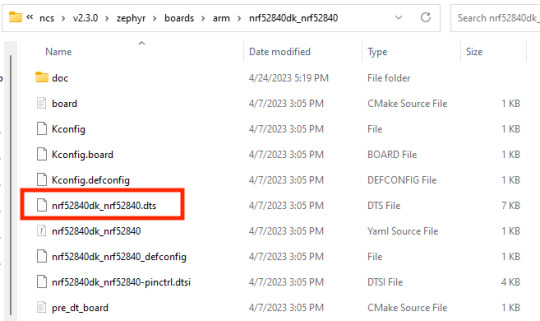
".dts" is the extension for the "top-level" devicetree file, and ".dtsi" is the extension for intermediate devicetree files that are referenced by the top-level devicetree. It is possible for intermediate devicetree files to contain other intermediate files. The node that represents the LEDs on the board is visible in the nRF52840 development kit's top-level devicetree file, "nrf52840dk_nrf52840.dts," when we open it in the example above!
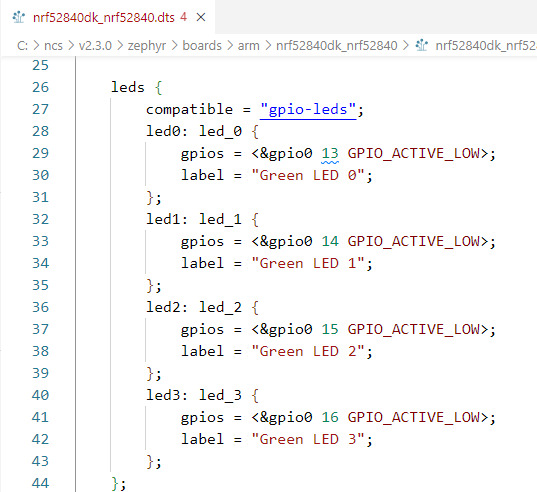
If we scroll to the top of this file, we see the following statements: /dts-v1/;#include <nordic/nrf52840_qiaa.dtsi>#include "nrf52840dk_nrf52840-pinctrl.dtsi"
We discovered how to incorporate support for custom hardware into our Zephyr-based firmware using the "Devicetree" in this blog post. We learned how to describe LEDs on a board and specify the corresponding GPIOs from a "blinky" example. Additionally, we discovered where devicetree files are located within the Zephyr repository and how their arrangement enables the description of boards, beginning with the CPU.
Utilizing device drivers created by others is one of the biggest benefits of using devicetree files in Zephyr over other mechanisms provided by MCU vendors in their IDEs. Usually, we have to write driver code from scratch or import libraries in various MCU-specific environments and IDEs. Instead, we can take advantage of other people's work by using Zephyr's devicetrees and device driver model. We can concentrate on crafting our final application's business logic. We will examine Zephyr's internal workings in the upcoming blog post to learn how it uses devicetrees and how it varies from the Linux kernel.
Ready to integrate your custom hardware into Zephyr-based firmware efficiently? At Silicon Signals, we excel in embedded systems development, offering expertise in hardware design, firmware development, and system optimization. Leverage our capabilities to streamline your projects, utilizing tools like Zephyr's devicetrees and driver models to focus on what truly matters—your application's core functionality.
👉 Get in Touch to explore how we can help you accelerate your embedded solutions!
1 note
·
View note
Text
USB Device Driver Course Online
Learn Advanced Embedded Linux ARM USB Device Driver Course Online – Certified Training Available Worldwide.

Noida, India—Are you an engineering student or expert looking to learn Embedded Linux ARM device drivers? Join our Advanced Embedded Linux ARM Training and advance your skills! This path is designed to offer hands-on experience with Linux device drivers, ARM board convey-up, Linux internals, and real-world projects.
What You’ll Learn:
Embedded Linux fundamentals and ARM board setup
Linux device driver improvement and debugging
Working with hardware interfaces and peripherals
Practical ARM-based total tasks for palms-on getting to know
Our schooling is led by enterprise experts with years of experience in embedded structures and Linux development. The route gives an established mastering path to assist students in building information in embedded programming, kernel improvement, and device motive force implementation.
Who Can Join?
Engineering students (ECE, CSE, EE, etc.)
Professionals in embedded software program improvement
Anyone captivated by Linux and ARM-based structures
Why Choose Us?
✔ Live Online Classes & Self-Paced Learning
✔ Practical Hands-on Projects
✔ Certification Upon Completion
✔ Guidance for Industry-Oriented ARM Projects
We offer schooling in Noida, India, and global–overlaying cities like Texas, Cambridge, Chicago, Sydney, Perth, Tampa, Brisbane, Melbourne, New York, Quebec, British Columbia, Ontario, Calgary, Alberta, and Yorkshire.
Start your journey in Embedded Linux ARM development nowadays! Enroll now and gain the competencies needed to excel in the embedded industry.
📞 Contact us at +91-8527567776 for more details and registration.
Click to:Chat on WhatsApp
Mail Us: [email protected]
🌐 Visit: Emblogic - USB Device Driver Course Online
#embedded linux arm training#linux device drivers#linux internals#arm board bring up#arm projects#embedded linux course#embedded linux course noida#embedded linux arm course
0 notes
Text
Emertxe Embedded Systems Online Course – A Gateway to a Thriving Career
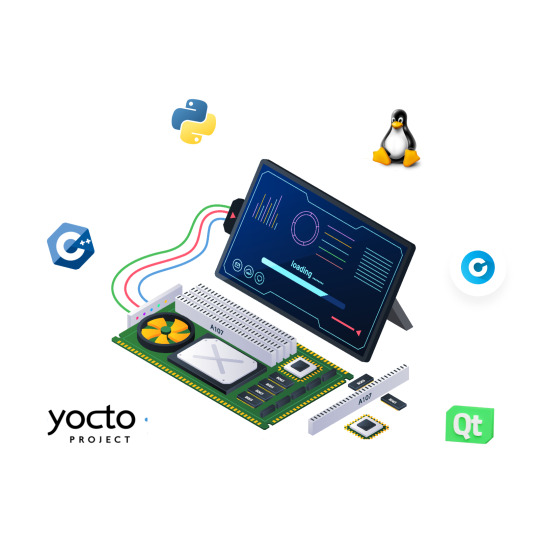
Are you looking to kickstart your career in embedded systems but don't have the time to attend traditional classroom-based courses? Emertxe's Embedded Systems Online Course offers the perfect solution to gain in-depth knowledge and practical experience in this rapidly growing field from the comfort of your home.
Why Choose Emertxe’s Embedded Systems Online Course?
Emertxe is a leading provider of embedded systems training, offering specialized online courses designed to bridge the gap between academic knowledge and industry requirements. With its embedded systems online program, you can gain expertise in key areas such as microcontrollers, real-time operating systems (RTOS), device drivers, communication protocols, and much more.
Here’s why Emertxe’s embedded systems online course stands out:
1. Industry-Recognized Curriculum
Emertxe’s course content is developed in collaboration with industry experts and aligned with the latest trends and technologies in embedded systems. The online embedded systems program includes everything from the basics to advanced topics, ensuring that you are well-prepared for industry challenges.
2. Hands-on Learning Experience
Emertxe’s online embedded systems course focuses heavily on practical learning. You will work on real-time projects, assignments, and simulations that help solidify your understanding and improve your problem-solving skills. Emertxe’s online platform makes it easy to access tutorials, lab sessions, and code examples anytime, anywhere.
3. Experienced Trainers
Learn from highly qualified instructors who have hands-on experience in embedded systems development. Emertxe’s trainers are industry veterans who share their insights and guide you through the complexities of embedded system design and implementation.
4. Flexible Learning Pace
One of the key advantages of the Emertxe embedded systems online course is the flexibility it offers. You can learn at your own pace, revisit lessons whenever needed, and balance your studies with personal and professional commitments.
5. Job Placement Assistance
Emertxe provides placement assistance to its students. With its strong industry connections and a network of partner companies, Emertxe helps students get placed in top tech companies. Graduates of the online embedded systems program are highly sought after for roles such as Embedded Engineer, Firmware Developer, and Hardware Design Engineer.
Key Topics Covered in Emertxe’s Embedded Systems Online Course
Introduction to Embedded Systems: Learn the fundamentals of embedded systems, including their applications in various industries like automotive, consumer electronics, healthcare, and more.
Microcontroller Programming: Get hands-on experience in programming microcontrollers like ARM and AVR to build embedded solutions.
Real-Time Operating Systems (RTOS): Dive into RTOS concepts such as task scheduling, inter-process communication, and memory management to design responsive embedded systems.
Embedded C and C++ Programming: Master the core languages used in embedded systems programming and develop efficient, resource-constrained applications.
Device Drivers and Communication Protocols: Learn to develop device drivers and implement protocols like UART, SPI, I2C, and CAN to ensure seamless communication between components in embedded systems.
Embedded Linux: Explore the power of Linux in embedded systems and understand how to work with Linux kernel, drivers, and file systems.
Career Opportunities After Completing Emertxe’s Embedded Systems Online Course
Graduating from Emertxe’s embedded systems online program opens the doors to a wide range of career opportunities. The demand for skilled embedded systems professionals is soaring in sectors like automotive, aerospace, telecommunications, and consumer electronics. Emertxe’s curriculum equips you with the expertise needed to take on roles such as:
Embedded Systems Engineer
Firmware Developer
Embedded Software Developer
Hardware Engineer
Embedded Systems Consultant
How to Enroll in Emertxe’s Embedded Systems Online Course
Enrolling in the Emertxe embedded systems online course is simple. Visit the Emertxe website, select the online course option, and follow the easy steps to complete your registration. With flexible payment plans and a dedicated support team, Emertxe ensures that the entire process is smooth and hassle-free.
Final Thoughts
Emertxe's embedded systems online course is the perfect way to build a solid foundation in embedded systems while balancing your existing commitments. With a comprehensive curriculum, hands-on projects, and job placement assistance, Emertxe ensures that you are ready to take on exciting career opportunities in embedded systems development.
Ready to kickstart your career in embedded systems? Visit Emertxe Embedded Systems Online Course and enroll today!
0 notes
Text
Mixtile Edge 2 Kit– AI based bee detection and tracking
Here I describe usage of Mixtile Edge 2 Kit in agriculture, bee detection, which can be essential for health and survival of bees.
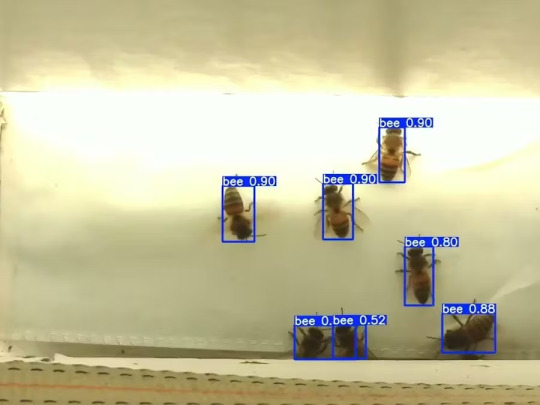
Story
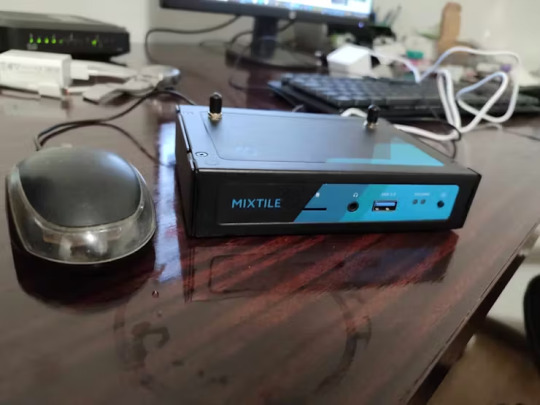
Mixtile is professional IoT hardware solution provider specialized in Linux and Android-based embedded systems.Mixtile Edge 2 Kit is high-performance ARM single board computer. It comes in variants of 2GB of LPDDR4 DRAM and 16GB eMMC Flash storage, or 4GB of LPDDR4 DRAM and 32GB eMMC Flash storage. This single board computer comes with preinstalled Android 11, and it runs Ubuntu Linux operating system in Android container. It comes with large connectivity options (Bluetooth, 4G/5G Cellular, GPS, and Lora, Zigbee and Z-Wave). For those, you will need module, but it comes with default onboard Wi-Fi connectivity, Gigabit Ethernet Port (RJ45) and Serial Port (RS-485). Because it comes with RS-485 port, which is industrial standard, and it comes within a strong metal case, it seems to me that it can be really used in industrial projects. I used official Raspberry Pi 5 power supply in order to power up my Mixtile Edge 2 Kit.So, an idea came to me why not to use it in agriculture, bee detection, which can be essential for health and survival of bees.This project will cover setting up Mixtile Edge 2 Kit, and custom photo dataset form video in order to train custom YOLOv5 bee detection model. YOLOv5 models must be trained on labelled data in order to learn classes of objects in that data.I gathered data from video and trained model on my PC.To train a model, I used python and typed in command line:
python train.py --img 640 --batch 16 --epochs 3 --data coco128.yaml --weights best.pt
My training results are summarized in the following table:
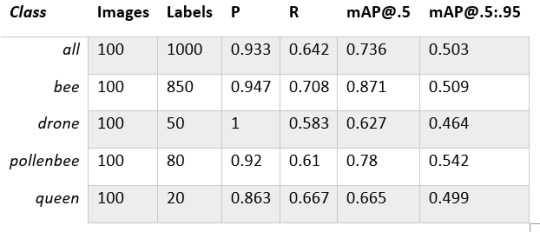
Training results
From this table you can see that images are divided into 4 detection classes:
Bee
Drone
Pollenbee
Queen
Example for each class is summarized in a table below:

Bee classes
1. Getting started
First, I will write about software part of the project, and later on steps of starting the recognition.
1.1 What is YOLOv5?
If you have been in the field of machine learning and deep learning for some time now, there is a high chance that you have already heard about YOLO. YOLO is short for You Only Look Once. It is a family of single-stage deep learning-based object detectors. It was written using Python language, and the framework used is PyTorch.
To ease control, I connected usb mouse to the one of three Mixtile Edge 2 Kit USB3 port. I used Ubuntu Linux for this project. Ubuntu on container is installed in Android system of Mixtile Edge 2 Kit by default. When you boot Mixtile Edge 2 Kit, you get Android OS. Since I wanted to access Edge 2 Kit remotely, and get easier control, I installed droidVNC server from this link:
It is an Android VNC server using Android 5+ APIs. It does not require root access.
I started the VNC server, connected with VNC Viewer and I got the following Android 11 screen:

Android 11
After that, I installed SimpleSSHD from this link:
SimpleSSHD is a SSH server Android app, based on Dropbear.It allows user access (user ssh) or full root access (by setting the login shell to /system/xbin/su) (if root is allowed).
After I installed SSH server, I connected to it via putty SSH terminal. Username and Password are root/root.
Com.hubware.ubuntu is ubuntu on a container and we are connected to it immidiately.
Now we are going to install required software.
First, you will need to upgrade Ubuntu by typing in the command: apt-get upgrade.
Second, I installed python by typing: apt-get install python.
You will also need pip, the package installer for Python.
2. Installing the YOLOv5 Environment
To start off we first clone the YOLOv5 repository and install dependencies. This will set up our programming environment to be ready to running object detection training and inference commands.
Install git: apt-get install git
Clone YOLOv5 repository:
git clone https://github.com/ultralytics/yolov5
Move to YOLOv5 folder:
cd yolov5
Install dependencies:
pip install -r requirements.txt
Wait some time to download and install all requirement packages, I waited 25 minutes, because there are a lot of python packages to install besides YOLOv5. YOLOv5 needs numpy package, scipy, OpenCV, etc.
The putty connection and installation process looks like below:
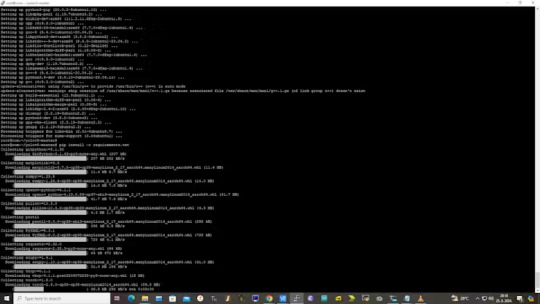
I transferred my model best.pt to the yolov5 installation folder via SCP, with MobaXterm.
You can simply download my model immidiate by typing:
wget https://github.com/sdizdarevic/beedetectionyolov5/raw/main/best.pt
Also, download original video by typing:
wget https://sdizdarevic.typepad.com/cr/bees-orig.mp4
Now, the final step is detection, and we are interested in the “result” content video.
python3 detect.py --weights best.pt --source bees-orig.mp4
The process of detection looks like below:

In the last lines from last picture we can see the detected number of bees at any point in time.
The summarized short steps to follow are below:
git clone https://github.com/ultralytics/yolov5
cd yolov5
pip install -r requirements.txt
wget https://github.com/sdizdarevic/beedetectionyolov5/raw/main/best.pt
wget https://sdizdarevic.typepad.com/cr/bees-orig.mp4
python3 detect.py --weights best.pt --source
Demonstrated videos are on urls with detection finished completely on Mixtile Edge 2 Kit. Output video is in folder runs/detect/exp2.
Original video:
youtube
Result video:
youtube
Last, but not less important: If you want to safely turn off your Mixtile Edge 2 Kit, I recommend you to install Shutdown (no Root) application: https://play.google.com/store/apps/details?id=com.samiadom.Shutdown&hl=en.
3.Conclusion:
After testing I found out that the Mixtile Edge 2 Kit is designed with wide range of applications, from industrial applications, IOT devices, smart home automation, to more than capable AI and edge detection. It is low powered device, with a lot of built-in connectivity options.
I would like to thank amazing Mixtile people for creating this amazing peace of hardware and especially for sending me the Mixtile Edge 2 Kit. Also, Mixtile nurtures the open source values and software, and I believe more people and companies will be involved in making projects with this board.
All in all, I recommend this board for implementing types of projects I described here.
0 notes
Text

Features and Applications of Debian/Arch Linux ARM OS
1. Core Features of Debian ARM
(1) Stable and Reliable Foundation
Community-maintained: Developed by global contributors without commercial influence
Extended support cycle: 5-year security updates for each stable release (extendable to 10 years via LTS project)
Rigorous quality control: Packages undergo strict stability testing before entering stable repos
(2) Broad Hardware Compatibility
Supports full ARMv7/ARMv8 architectures from Cortex-A7 to A78
Officially maintains ports for over 20 single-board computers (including all Raspberry Pi models)
(3) Lightweight Design
Minimal installation requires only ~128MB RAM
Offers systemd-free Devuan branch alternative
(4) Software Ecosystem
Includes over 59,000 precompiled packages
Provides newer software versions via backports repository
2. Typical Applications of Debian ARM
(1) Server Domain
Low-power ARM servers (e.g. AWS Graviton instances)
Network infrastructure (routers, firewalls)
(2) Embedded Systems
Industrial control equipment (requiring long-term stable operation)
Medical devices (compliant with IEC 62304 standard)
(3) Education & Research
Computer architecture teaching platforms
Scientific computing cluster nodes
3. Core Features of Arch Linux ARM
(1) Rolling Release Model
Provides latest software versions (kernel/toolchain etc.)
Daily synchronization with upstream Arch Linux updates
(2) Ultimate Customization
Build from base system according to needs
Supports custom kernel compilation (e.g. enabling specific CPU features)
(3) Community Support
Active AUR (Arch User Repository)
Detailed Wiki documentation
(4) Performance Optimization
Default ARM-specific compilation optimizations
NEON instruction set acceleration support
4. Typical Applications of Arch Linux ARM
(1) Development Platform
Embedded development testing environment
Kernel/driver development platform
(2) Enthusiast Devices
Customized smart home hubs
Portable development workstations
(3) Cutting-edge Technology Testing
New architecture validation (e.g. ARMv9)
Machine learning framework experimentation
5. Comparative Summary

6. Usage Recommendations
Choose Debian ARM: For mission-critical systems, industrial control requiring long-term stability
Choose Arch Linux ARM: For latest software features, hardware R&D or deep customization
0 notes
Text
Unlock Your Potential with Embedded Systems Training at IPCS Global
Introduction: In today’s tech-driven world, the demand for skilled professionals in embedded systems is constantly growing. From smartphones to medical devices, embedded systems play a crucial role in powering various electronic devices. If you’re looking to kickstart or advance your career in this exciting field, IPCS Global offers comprehensive embedded systems training programs designed to equip you with the necessary skills and knowledge.
Why Choose IPCS Global for Embedded Systems Training? 1. Industry Expertise: IPCS Global brings years of experience and expertise in providing training in embedded systems. With a team of seasoned professionals, you can rest assured that you’re learning from the best in the industry.
2. Hands-On Learning: Our training programs focus on practical, hands-on learning experiences. You’ll have access to state-of-the-art labs equipped with the latest hardware and software, allowing you to gain real-world experience and develop practical skills.
3. Customized Curriculum: At IPCS Global, we understand that one size doesn’t fit all. That’s why our training programs are tailored to meet the specific needs and requirements of our students. Whether you’re a beginner or an experienced professional looking to upskill, we have a program for you.
4. Industry-Relevant Projects: As part of our training programs, you’ll have the opportunity to work on industry-relevant projects. This not only enhances your learning experience but also gives you valuable insights into the real-world applications of embedded systems.
5. Expert Faculty Support: Our team of expert faculty members are dedicated to helping you succeed. With their guidance and mentorship, you’ll be able to overcome challenges and achieve your goals in embedded systems.
Training Programs Offered: 1. Embedded Systems Design 2. Embedded C Programming 3. ARM Microcontroller Programming 4. IoT (Internet of Things) Development 5. Real-Time Operating Systems (RTOS) 6. Embedded Linux Development 7. PCB Design and Fabrication
Who Can Benefit from Our Training Programs? - Engineering Students - Electronics and Communication Professionals - IT Professionals looking to switch careers - Entrepreneurs looking to venture into the embedded systems domain
Conclusion: Embark on a rewarding career journey in embedded systems with IPCS Global. Our comprehensive training programs, industry expertise, and hands-on learning approach ensure that you’re well-equipped to meet the demands of the ever-evolving technology landscape. Take the first step towards unlocking your potential today!
For more information and to enroll in our training programs, visit our website or contact us directly. Let IPCS Global be your gateway to success in the exciting world of embedded systems.
0 notes
Text
🚀 Enhance the Efficiency and Precision of Smart Motion Control Systems!
Smart motion control systems are crucial in industrial automation, managing mechanical motion in real time. We recommend the Forlinx Embedded FET6254-C SoM, built on TI Sitara™ AM62x processors, featuring a high-performance multi-core architecture and rich interfaces for precise control and efficient data processing. 🌟
Whether robotic arms or automated assembly lines, the FET6254-C SoM helps boost production efficiency, reduce energy consumption, and drive industrial intelligence forward! 💡
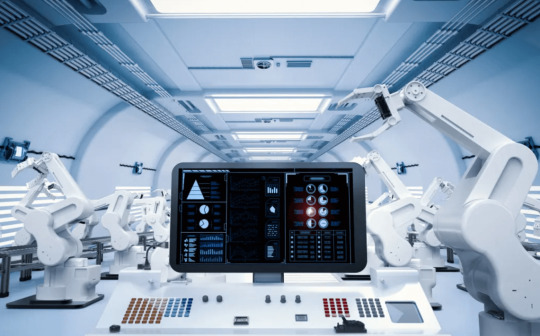
We(Forlinx) can provide TI, NXP, Allwinner, Rockchip and Renesas ARM SoM/CoMs, single board computers, android/Linux/RTOS boards, and High-quality NXP i.MX ARM Cortex-A72/53/55/9/7 modules. Worldwide shipping.
Email: [email protected]
Web: www.forlinx.net
#SmartMotionControl#IndustrialAutomation#FET6254CSoM#TIProcessors#RealTimeControl#Robotics#EnergyEfficiency#AutomationTechnology
0 notes
Video
youtube
WHO WE ARE ?
We NEW QBITRONICS working in Embedded Systems. We are Research & Development , Testing & Servicing the products of Industrial Automation, Agricultural Automation, Home Automation.
Technology:
Embedded System, Wireless Industrial Automation &Robotics
IOT SERVER AUTOMATION
LORA WAN LONG RANGE
AI WIRELESS AUTOMATION
MACHINE LEARNING
EMBEDDED PLC
Platform: IOT, LORA,RF-Long Range Protocol, IR,RS485
We have Expertise in a wide range of wireless Technologies such as Automation of RF/LORA 3-Phase, Led Drives, Power Factor, Hydroponics, Android App, Genset(AMF),Solar Power, IOT Products and Power energy.
R&D with Tool Development
Embedded software development
IoT solution development
Custom firmware development
ARM Linux 3D development
CONTACT US
1156,BEHIND SUNGAM SINDAMANI BUS STOP,
ROAD,RAMANATHAPURAM,COIMBATORE 641045,
TAMILNADU, INDIA.
www.qbitronics.com
Whatsapp no:9629659111 PH NO:0422-3593306
0 notes
Text
AdLink I-Pi SMARC 1200 Plus DevKit With MediaTek Genio 1200

I-Pi SMARC 1200
AdLink I-Pi SMARC 1200 Plus DevKit, an octa-core MediaTek Genio 1200 processor-powered AI and graphics-focused solution. The octa-core Arm Cortex-A78 and Cortex-A55 CPUs in the Genio 1200 are paired with a 5-core Arm Mali-G57 GPU for cutting-edge 3D graphics and an embedded NPU that can handle up to 5 TOPS of edge AI data.
The on-device AI processing capabilities of the I-Pi SMARC 1200 include computer vision and deep learning neural network acceleration. Moreover, up to three MIPI camera inputs and several 4K displays are supported by the SMARC. For a variety of next-generation AI focused developments, including smart homes, industrial IoT, 3K multimedia apps, and human-machine interfaces, this is the go-to option. Product developers can explore new avenues and expedite proof of concept creation before production with the dev kit, which lowers costs and shortens time to market.
Pi SMARC 1200
MediaTek Genio 1200 platform
The Octa-core MediaTek MT8395 powering the LEC-MTK-I1200 module (Cortex-A78 x4 + A55 x4 in the arm)
The Smart Mobility Architecture, or SMARC Form Factor
SMARC 2.1 specification: a very small and power-efficient design appropriate for edge computing and embedded applications.
Due to its small size (82 x 80 mm), it is perfect for designs that need to save space, like industrial IoT systems, robotics, smart home appliances, and AI cameras.
All-encompassing Connectivity
Support for Bluetooth 5.2 and Wi-Fi 6 allows for fast wireless data transfer.
Support for optional 5G: Enables cellular high-speed connectivity for Internet of Things applications that need dependable network access.
Gigabit Ethernet: Quick connectivity for edge devices via wired networks.
Display and Graphics
Equipped with a Mali-G57 GPU, capable of encoding and decoding 4K60 HDR video.
There are several display interfaces available for connecting high-definition monitors and displays, including as HDMI, eDP, and MIPI DSI.
A Variety of I/O Interfaces
Peripheral connectivity via PCIe, USB 3.1, and I2C enables expansion with extra parts including cameras, sensors, and storage devices.
AI cameras can be connected via the MIPI CSI camera interface, which is helpful for robotics and smart surveillance applications.
AI & Machine Learning on the Edge
For real-time decision-making, the AI Processing Unit reduces dependency on cloud computing by enabling effective AI inferencing at the edge.
Perfect for jobs involving natural language processing, computer vision, and machine learning.
Stored Information and Memory
Supports high-speed memory operations with LPDDR4x RAM.
Sffers external SD card ports, UFS, and eMMC as storage options.
Low Power Need
It is appropriate for battery-powered IoT devices such as smart cameras, portable robotics, and IoT sensors because it was designed with energy efficiency in mind.
Uses in Industry
Suitable for industries where AI and IoT solutions are essential, such as smart manufacturing, smart cities, healthcare, and retail.
Creation and Personalization
Offers compatibility for Linux, Android, and other embedded operating systems together with a thriving software ecosystem.
Gives developers the ability to design unique apps and solutions for AI-powered Internet of Things gadgets.
Read more on Govindhtech.com
#X870ETaichi#AMDRyzen9000Series#graphicscards#motherboards#miniPCs#Gamingmonitor#AMDRyzen#CPUperformance#DDR5RAM#news#technews#technology#technologynews#technologytrends#govindhtech
0 notes